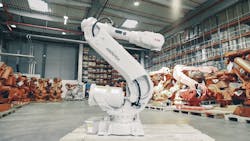Recycling and refurbishment programs for old equipment have proven increasingly popular for a multitude of reasons. In addition to improving sustainability by shrinking the carbon footprint associated with manufacturing new machines, remanufacturing is desirable simply because it cuts costs. Often, refurbished robots and other pieces of industrial equipment are significantly less expensive, allowing small and medium-sized manufacturers to begin automating more easily.
ABB’s buy-back service for previously owned robots provides these benefits, while also allowing those divesting themselves of outdated robots to ensure that their once-valued piece of equipment does not become mere dead weight.
After being repurchased and brought to one of ABB’s Remanufacture and Workshop Repair Centers, robots undergo a rigorous inspection, including a 16-hour test of their functionality, before becoming ABB-certified remanufactured equipment and being placed back on the market. Remanufactured robots include two-year warranties and support from local service teams, including assistance with installation and training. In addition to remanufacturing robots, ABB also refurbishes associated peripherals, such as controllers and manipulators.
“Unlike third-party refurbishers, who only fix faulty parts, we completely remanufacture our robots using original ABB design plans, specifications, and dimensional data. This guarantees that the robots offer the same levels of quality, performance, durability, and safety as a new ABB robot,” said Jan Borsky, sales manager of ABB’s Global Remanufacture and Workshop Repair Centers. “We have one of the largest inventories of pre-owned and reconditioned robots across the world, with 400 robots of various types in stock for sale, and currently the demand for second life robots is so high that we have more than one robot leaving our Ostrava facility (in the Czech Republic) every working day.”
The remanufactured robots can often be integrated with new software and controllers to unlock previously unavailable functionality. For instance, ABB’s SafeMove software, which allows robots to engage in safety-monitored stops as well as speed and separation monitoring for collaborative tasks, can be used with many of ABB’s older models once they are remanufactured.
According to Borsky, remanufactured robots benefit a variety of different customers, including those looking to extend the lifetime and functionality of the robots they already own, those interested in a low-cost option for their first robot, and those who want additional robots for an existing production line but have found that the specific model they require has been discontinued.
In addition to the Ostrava facility, ABB has remanufacturing facilities in Shanghai, China, and Auburn Hills, Michigan.
About the Author
David Miller
Former Senior Technical Writer

Leaders relevant to this article:

